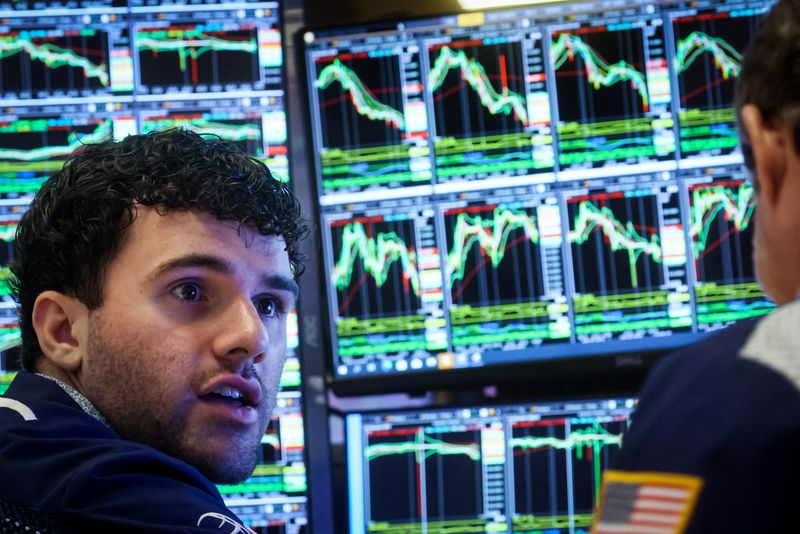
Pain trade or same trade? Investors refuse to fold on recession bets By Reuters

© Reuters. Traders work on the floor of the New York Stock Exchange (NYSE) in New York City, U.S., July 6, 2023. REUTERS/Brendan McDermid
By Naomi Rovnick, Marc Jones and Alun John
LONDON (Reuters) – It was not meant to be this way. The big trades championed at the start of 2023 look redundant thanks to AI mania in stock markets, and long-predicted recessions that were supposed to fire up fixed income have proved elusive.
Slowing growth was meant to make it a mediocre year for world stocks. Yet here they are up 13%, with the ‘big tech’ set up over 70%.
Bonds were supposed to rally as recessions brought rate cuts, but borrowing costs and 10-year U.S. Treasury yields are higher and everything risky, from bitcoin to emerging market debt, has smashed it out the park.
Data suggests recession risks remain high, but wages and U.S. and European interest rates are also still rising – so stick or twist?
Here are five big calls investors are now making.
1/ STICK WITH BONDS
Francesco Sandrini, head of multi-asset strategies at Amundi, Europe’s largest fund manager, said the group started the year positive on Treasuries as it positioned for an end to U.S. rate rises and the world’s largest economy turned lower.
“We were wrong, like all the asset managers in the world,” he said.
“We may be wrong for another couple of quarters,” he added, saying a meaningful economic slowdown was “a matter of time”.
Investors polled by Reuters in January expected 10-year Treasury yields to fall to 3.25% by end-2023 but sticky inflation and hawkish central banks have kept yields higher.
Those yields are now near 4%. U.S., German and British 2-year yields just touched their highest since 2007-2008.
And the Treasury yield curve, widely viewed as a rock-solid recession indicator, is more inverted than any time since the early 1980s.
Principal Global Investors chief global strategist Seema Shah said she maintained her view that government bonds would do well with recession still likely by year-end.
2/ FOMO IN FULL SWING
Bets against equities have been left in tatters as the frenzied excitement around artificial intelligence has sent the super-sized U.S. tech companies that now dominate the global indexes up a combined 73% this year.
But those stellar gains also mean the largest 10% of U.S. stocks now make up 75% of overall U.S. equity market cap. This concentration level, according to Absolute Strategy Research, is the highest since 1932.
JP Morgan warned in a note to clients: “FOMO (fear of missing out) is in full swing, there is complacency being built into stocks,”, pointing to the low levels of Wall Street’s ‘fear gauge’, the volatility index.
Trevor Greetham, head of multi-asset at Royal London Asset Management, said he had been buying equities “on contrarian grounds” since October but now stood ready to move into bonds and gold.
Florian Ielpo, head of macro at Lombard Odier Investment Managers, is wary that key indicators such as U.S. manufacturing data and European purchasing manager indices are souring.
“It is important to understand that sentiment is bullish and the macro-economics are bearish and you need to reconcile the two,” he said. “Can we lead off sentiment for another two quarters? I doubt it”.
3/ LAND OF THE RISING YEN
The big FX bet for 2023 was for the rate-sensitive yen to strengthen due to U.S. rate cuts and Japan ending ultra-loose monetary policy.
No sign yet though, and the yen, which started 2023 around 131 per dollar, is now sitting just under 140 after a late June trip to 145.
The is below January levels as the euro, pound and Swiss franc rally.
Athanasios Vamvakidis, head of G10 FX strategy at Bank of America (NYSE:), expects the greenback to strengthen again, with the euro falling to $1.05 from around $1.10, thanks to the Fed keeping U.S. rates high before the eventual recession supports the currency on safe-haven bids.
He forecasts dollar/yen at 147 by end-September.
Morgan Stanley (NYSE:) just turned “tactically bullish” on following its poor start to the year.
4/ FRAGILE CHINA
Spluttering data, property market woes and meek economic stimulus have also busted new year bets of a Chinese mini-boom.
Stocks there have underperformed and ‘junk’-rated Chinese debt, mostly in the property sector, has suffered another relapse.
Proving the forecasters wrong in a positive way, emerging market local currency debt has delivered an 8% ‘total return’ year-to-date, one of the strongest six-month performances in the past 10 years.
That’s thanks to the developing world being ahead of the curve in terms of switching from rate hikes to cuts.
This has cut the additional interest rate, or ‘spread’, investors get for buying local FX emerging market bonds rather than U.S. bonds close to all-time lows, which has been enough for Morgan Stanley and JPMorgan (NYSE:) to dial down their bullish calls this week.
5/ CLATTERED COMMODITIES
There might not have been a recession yet but commodities have been clattered this year as if there had been.
JPMorgan points out that investor positioning across energy, base metals, grain and oilseeds and environmental/carbon markets is largely on a par, or even weaker than, levels seen at the peak of COVID-19 panic.
Principal Global Investors’ Shah said she still expected commodities to continue to struggle “because a combination of U.S. slowdown plus China slowdown should mean weak demand.”
Longer-term supply constraints meant the sector was worth moving back into, though, on any signs of stronger Chinese stimulus or that U.S. demand will recover once the anticipated recession is over.
Stay connected with us on social media platform for instant update click here to join our Twitter, & Facebook
We are now on Telegram. Click here to join our channel (@TechiUpdate) and stay updated with the latest Technology headlines.
For all the latest Education News Click Here
For the latest news and updates, follow us on Google News.

